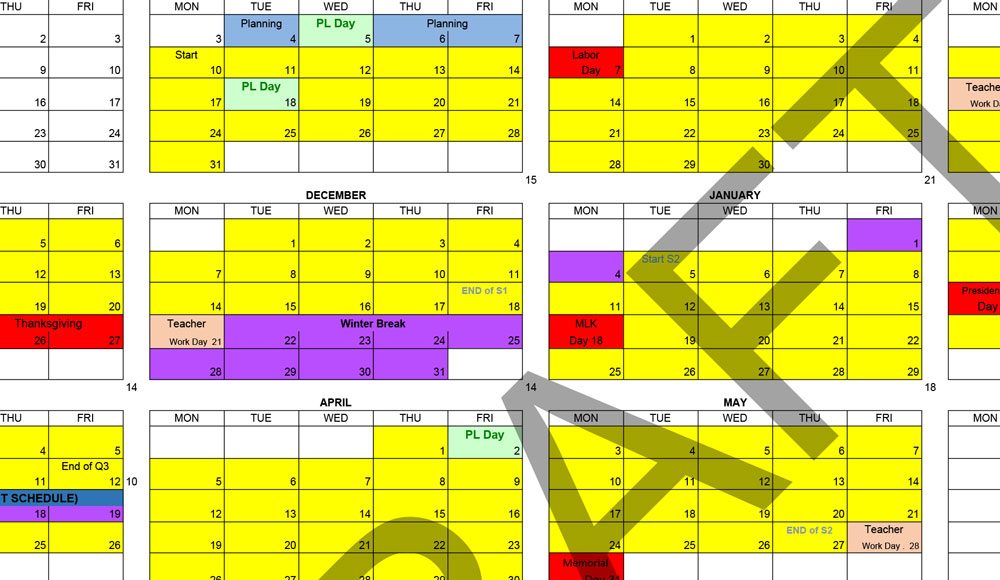
Next year’s school calendar will largely mirror this year’s, but with two days off for students built into the schedule to accommodate primary and general election days. Several hurricane make-up days are also built into the schedule.
The Flagler County School Board got its first look at next year’s calendar during a workshop Tuesday and signaled it would approve it at its next meeting later this month. The calendar was the product of an administrative committee that approved it unanimously.
The 2020-21 school year will begin School will begin for teachers on Tuesday, Aug. 4, and for students on Monday, Aug. 10, 2020, ending for students on May 22, 2021, and for teachers a day later.
“It pretty much mirrors the calendar that we’ve had for the last couple of years other than next year we have the primary and general elections,” Earl Johnson, the senior administrator who presented the calendar to the board, said.
Elections Supervisor Kaiti Lenhart and school board members had agreed weeks ago to minimize the presence of students on campus on election days, when six of the district’s nine traditional schools are used as polling places, and 19,000 voters are registered in precincts that use those schools.
The Legislature passed a new law this year that requires all polling places to be regulated the same way, whether on or off school campuses. That means politicking by candidates must be allowed on school campuses, as it would be elsewhere, as long as it takes place 150 feet or more from the polling site. Previously, the school district had kept politicking off its campuses, supplanting its own policies. That’s no longer permissible. With that in mind, board members were concerned that the mix of politics, voting and students would be potentially disruptive to campuses, and even possibly unsafe: thousands of voters would be going through campuses without having to sign in. So the board asked the calendar committee to look at making election days off days for students.
That will be the case for August 18, primary election day, and Nov. 3, general election day.
The first semester will consist of 85 days and will still be completed before winter break, which stretches for students two weeks from Dec. 21 through Jan. 4. The new semester will begin on Tuesday, Jan. 5. Thanksgiving week remains a full week off, from Nov. 23 through the 27th, assuming bad weather doesn’t interfere.
But as was the case this year, when three school days were lost to bad weather, it would take four days to begin encroaching on Thanksgiving week. “A few years ago we added some additional time in the school day, instructional school day,” Johnson said. Those additional minutes each day add up to two full days of instruction over the course of the year. So it’s only on the third day of lost time that there would be an impact on the calendar, and even then, October 12 and December 21, which would normally be professional learning days for teachers–and days off for students–would be used to make up time. In other words, it’s not before the fifth day lost to inclement weather that Thanksgiving Week would have to start giving up days back to instruction. “If we use all those days and we still need additional days, we will eat into our Thanksgiving vacation,” Johnson said.
The second semester would be 94 days of instruction. Aside from Thanksgiving, students will have spring break from March 15 through March 22. They’ll have days off on Sept. 7 (Labor Day), Nov. 11 (Veterans Day), Jan. 18 (Martin Luther King Day), and Feb. 15 (Presidents’ Day). By the time Memorial Day rolls around on May 31, they’ll already be off.
Starting and ending times for schools aren’t changing.
In future calendars, School Board member Colleen Conklin wants to explore the possibility of returning to occasional half days built into the schedule. “Every year we hear about the additional loss of time for teachers in the classroom, to do everything outside of direct instruction,” Conklin said, from planning to grading to other things. “Is there any way to get back to that place where we had half days built into the schedule where the kids still got credit for the day and the teachers still had time to do the things they needed to do.”
Curriculum Director Diane Dyer recalls those days. “Some parents didn’t like it because it presented problems for them, child care problems, in the afternoons,” Dyer said. “We also had some questions about how the time was being used, but we got much better at that in making sure that the time was being used appropriately. We just carved time out.” She suggested the district could ease back into such half days, perhaps on a quarterly basis. Conklin asked for an analysis of other districts still operating with half days to examine whether it has an effect on teacher or student absenteeism.
![]()
See the full calendar here.





























Leave a Reply